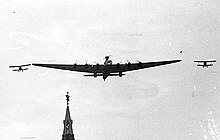"Maxim Gorki" agitation relay
The "Maxim Gorki" agitation squadron ( Agiteskadrilja imeni Maxima Gorkowo , Russian Агитэскадрилья имени Максима Горького ) was an air force in the Soviet Union that was set up and used for propaganda purposes in 1933 .
history
The squadron was founded with the command No. 332 on March 17, 1933 as part of the "civilian air fleet" for the 40th anniversary of Maxim Gorky's author on the initiative of the journalist Mikhail Kolzow . A fund had already been set up in advance and the large state newspapers such as Pravda issued appeals for donations, so that a starting balance of 11 million rubles was available. The squadron had the task of serving as a political information carrier over the great distances in the USSR. Accordingly, some of their planes were given the names of Soviet newspapers such as " Krasnaya Zvezda ", " Izvestia ", "Pionerskaya Pravda" or "Robotnika". The aircraft fleet comprised around 40–60 machines of various types such as the U-2 , Stal-2 and K-5 , but also individual pieces such as the gyroplane 2-EA , plus around 200 chartered ones. The flagship (“Flagman”) was the large five-engine ANT-14 “Pravda” aircraft , which completed around 1000 flights during the squadron, including one to Bucharest in 1935 . A unique specimen was a PS-9 that flew under the name of the magazine " Krokodil " and for this reason had a crocodile snout, back hump and corresponding painting designed by Vadim Schawrow .
On May 5, 1933, the day of the state press, the squadron was officially put into service at an airfield festival on the Chodynka field . This was followed by regular tours in various parts of the country with stopovers in factories and large farms ( collective farms , sovkhozes ), where political events and film lectures were then held. The ANT-14 made flights to larger cities such as Kharkov and Leningrad. In 1934, the ANT-20 "Maxim Gorki", also financed from donations and intended as the new flagship of the squadron, was built with eight engines and a 63 meter wingspan. It was supposed to function as a "flying agitation office" and was equipped with a printing press, loudspeakers and slide projectors with which images could be projected onto clouds, as well as neon letters on the underside of the wing. However, before it could be handed over to the squadron, the ANT-20 collided with an I-5 during a flight demonstration on May 18, 1935 and crashed. 50 people lost their lives in the accident.
On February 26, 1939, the agitation squadron was disbanded with Order No. 129. By then, their pilots had carried out around 320 propaganda trips, flown to 15,000 points and covered 55 million kilometers. The aircraft were sold to Aeroflot or handed over to the military sports organization OSSOAWIACHIM .
Activities in numbers
| Action taken | Until May 5, 1937 | Until January 1, 1939 |
|---|---|---|
| Landings in various regions of the country | 30,248 | 35,518 |
| Hours of flight performed | 25,753 | 29,070 |
| Settlements approached | 11,300 | 12,590 |
| Distributed publications / leaflets | 4,870,000 | 7,717,000 |
| Passengers for sightseeing flights | 53,000 | 69,680 |
| Film screenings | 71 | 205 |
literature
- Wilfried Copenhagen : Lexicon Soviet Aviation . Elbe-Dnjepr, Klitzschen 2007, ISBN 978-3-933395-90-0 .
Individual evidence
- ^ A b c Juri Albert, Ulrich Unger: Catastrophe over Moscow - The end of "Maxim Gorki" . In: Fliegerrevue extra . No. 31 . Möller, 2010, p. 50 .

